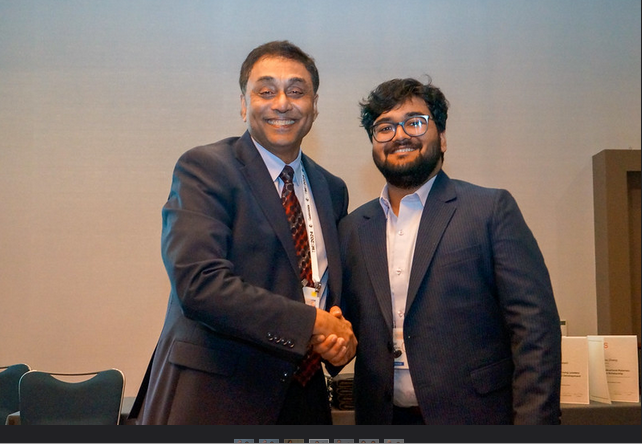Written by Yvonne Medina

Anush Singhal has worked closely with professors in the School of Materials Science and Engineering (MSE) to develop an exciting research profile investigating conjugated plastic polymers that have the potential to conduct electricity. He is now looking forward to joining the graduate school of engineering at UC Santa Barbara this fall to continue his research. While Anush’s research is theoretically sophisticated, its applications are immediately practical, and he can helpfully translate this work into layman’s terms using a selection of analogies to simple technologies we all interact with every day.
Polymers, of course, form the foundational structure of much of modern life which is filled with synthetic plastics and other constructed materials we tend to take for granted. When so much of our society relies on synthetic plastics, streamlining the production of these polymers benefits everyone and can help further global sustainability efforts. Conductive polymers is a fascinating field of research as it allows relatively cheaply made synthetic materials to replace significantly more expensive metallic or crystalline parts that are often used due to their high conductivity. Conductive plastic represents a way to cut costs associated with complex electronics, and has the potential to seriously change the global economy if, or perhaps, when, researchers can make this process more scalable. Anush’s research is trying to make that distant future a much closer reality. The questions that drive Anush’s research have practical applications such as “How do we make better and more sustainable polymers in industry? And how do we bridge the gap between laboratory work and industrial science?” These are questions that will continue to drive Anush’s research and will most likely become increasingly relevant as both the U.S. and global economy evolves.
Anush helpfully characterizes how the processing of conductive polymers works, drawing on analogies such as zippers and highways to illustrate theories on kinetics and processes of solidification to describe how these processes work on the particle level. Anush’s most helpful metaphor that explains his career goals might be the recipe book, however. Obviously, publishing materials science papers is very different from writing a book of recipes based on a personal repertoire of culinary techniques; however, Anush espouses this metaphor to the extent that he tells me, “I want to give future scientists a recipe book for how to create these polymers at the right temperature, size, and with the right interlocking mechanisms.” Organic chemistry is often equated to baking, and while this is an extreme oversimplification of a field that is often seen in the public image as the “weed out” class for STEM majors, sometimes the baking metaphor is apt; like a baker who does not want to compromise the texture of the final product by deviating too far from the recipe, researchers also need to know they have the right temperature calibration to produce the polymer structure they are working to achieve. This hypothetical recipe book, which will most likely take the form of a series of academic articles, will hopefully help future researchers unlock the conductive potential of polymers.
How easily the charge moves across the polymers is paramount when dealing with a general dielectric material like plastic. To illustrate this point, Anush makes the analogy of a scenic, winding road that takes longer to reach one’s destination versus a straight highway to describe the importance of these interlocking mechanisms. The latter approach is synthetic, for example; synthesis forces polymers to align in an interlocking structure that can be likened to a zipper; the other approach is to process the polymers as a whole to encourage them to act in ordered structures. The challenge for researchers is how to create order out of chaos by encouraging plastics to act in ordered structures like metals.
This gap between how these polymers should theoretically behave in these estimated structures, and how they actually behave, of course, must be identified in the laboratory. At its core, Anush insists, he and other researchers are trying to push something from a melted state to a solid state. While spin coding is common in academic labs, it is not widely used in industry because it is not a particularly scalable process as yet. This is where that hypothetical book of recipes will help future scientists until perhaps other methods become more scalable.
Anush’s focused research trajectory will continue to be honed in his graduate work and research career at UC Santa Barbara this fall. He cites his willingness to work closely with the research faculty here at MSE as integral to his success as an undergraduate researcher at Georgia Tech. The opportunities to work with experts in MSE at the undergraduate level has enriched his career prospects. Not only was Anush’s research recognized with a FMD Gilbert Chin Scholarship at The Minerals, Metals & Materials Society (TMS) annual meeting in March, but his community service to the scientific community was matched with a Battelle Materials Graduate Student Award. This research has led Anush to a satisfying and exciting career path bridging both academic research and industrial applications in polymer science.